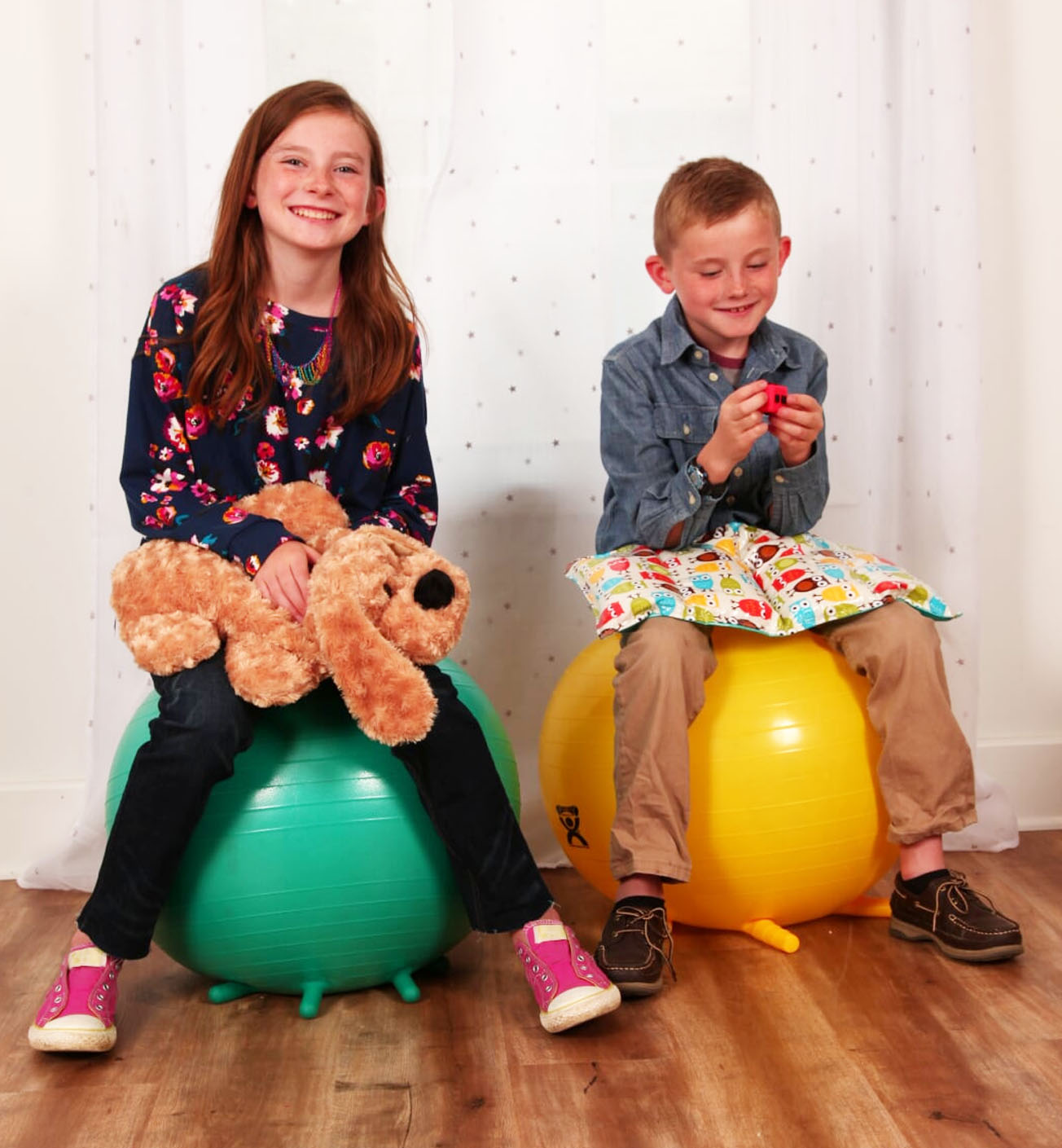Therapy balls, often called stability or exercise balls, are an incredibly versatile tool that can benefit people of all ages and abilities. Whether in physical therapy, sensory integration, or classroom settings, these inflatable balls offer a wide range of applications that promote balance, strength, and focus. In this article, we’ll explore how therapy balls can be used in different environments to support physical and cognitive development.
*Note/Warning – Therapy balls are designed to be used by occupational or physical therapists (or as recommended by/used under their professional expertise and guidance). They are not designed for athletic training. Do not use weights when exercising on therapy balls.
Occupational Therapy: Promoting Functional Skills and Core Stability
Therapy balls are a key tool in occupational therapy, where they are used to promote functional skills, core stability, and motor coordination. They help the body engage multiple muscle groups, making them ideal for a variety of therapy exercises and activities.
-
Core Strengthening: Sitting on a therapy ball or engaging in activities like ball passes can help strengthen the core muscles, which are essential for maintaining balance, posture, and stability during daily activities. Strengthening these muscles is particularly important for children and adults with developmental delays or motor challenges.
-
Motor Coordination: Therapy balls are often used to improve motor coordination by challenging the body to maintain balance while performing tasks. For example, reaching for objects, throwing beanbags, or catching stuffed animals while seated on a therapy ball can enhance hand-eye coordination and bilateral integration.
-
Postural Control: Therapy balls are excellent for improving postural control, which is the ability to maintain an upright position against gravity. Activities like balancing on a therapy ball can help individuals develop the strength and endurance needed for good posture in everyday tasks such as sitting at a desk or walking.

Sensory Integration: Supporting Focus and Regulation
In sensory integration therapy, therapy balls serve as both a calming and stimulating tool, depending on the needs of the individual. This makes them particularly useful for children and adults with sensory processing challenges.
-
Vestibular Input: Rolling or bouncing on a therapy ball can provide vestibular input, which is essential for balance and spatial orientation. This type of sensory input can help individuals with sensory processing difficulties better understand where their body is in space, leading to improved motor planning and coordination.
-
Proprioceptive Input: Activities like bouncing or squeezing a therapy ball, or using the ball as a "steam roller" can offer deep pressure input, which is calming and organizing for the nervous system. This type of input can be especially helpful for individuals who are sensory-seeking or need help regulating their sensory input.
-
Focus and Attention: For children with attention difficulties, sitting on a therapy ball instead of a chair can promote focus by allowing them to engage in subtle movement. This movement helps channel excess energy in a controlled manner, improving attention and reducing restlessness.

Classroom Settings: Encouraging Active Learning
Therapy balls are increasingly being introduced in classroom settings as an alternative seating option, supporting active learning and enhancing student engagement. One popular adaptation is the Ball Chair, which combines the benefits of therapy balls with the stability needed in a classroom or office environment.
-
Ball Chairs: These are therapy balls equipped with tiny feet to prevent them from rolling away when not in use. Ball chairs allow students (and adults) to engage in subtle bouncing or rocking movements while seated, helping them release excess energy without leaving their seats. This gentle movement encourages better posture, strengthens back muscles, and naturally facilitates attention and focus. Ball chairs are an excellent choice for classrooms and offices where a bit of controlled movement can enhance productivity and comfort.
-
Active Seating: Replacing traditional chairs with ball chairs, wobble stools, seat cushions, or other active seating allows students to move while seated, helping to burn off excess energy and improve concentration. The constant need to adjust posture encourages better sitting habits and reduces slouching.
-
Group Activities: Therapy balls can be incorporated into group activities, such as passing the ball in a circle, balancing it on a parachute, or using it in relay races. These activities promote teamwork, coordination, and physical activity in a fun, interactive way.
-
Stress Relief: The gentle bouncing or rocking motion that therapy balls provide can be soothing for students who might be feeling anxious or overwhelmed. This can create a more relaxed and focused learning environment.

Choosing the Right Size Ball Chair: Selecting the optimal size ball chair is essential for effectiveness. The easiest way to determine the correct size is to measure the child's arm length from the armpit to the middle fingertip, then choose the ball chair closest in size to that measurement. For example, if the measurement is 19 inches, you would select the 18-inch ball chair rather than the 22-inch model.
©2025 Therapy Shoppe® Incorporated. All rights reserved.
More articles you might enjoy:
The Benefits of Sensory Seating in Classrooms
Core Strength Exercises for Kids
10 Best Calming Tools for School Classrooms
Creating Sensory-Friendly Spaces: Designing Classrooms to Support All Students
The Benefits of Noise Dampening Tiles for Sensory Rooms and Classrooms

